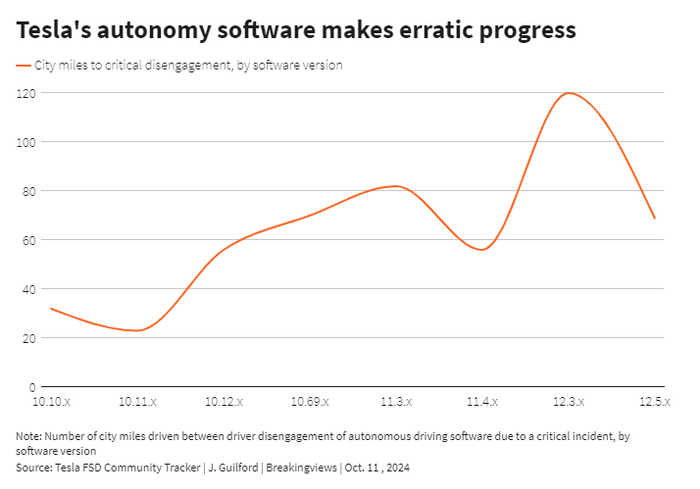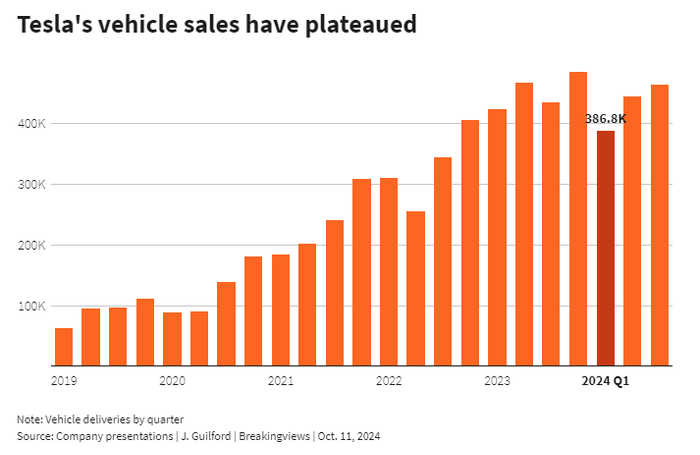Published 12:51 IST, October 12th 2024
Tesla chooses a harder set of unanswered questions
Musk also promises Tesla will update existing cars for truly hands-free driving, a step up from current assisted autonomy.
- Companies
- 3 min read

Unassisted driving. Elon Musk ’s pronouncements about $700 billion valued Tesla are often outrageously over-optimistic, but they used to be reasonably detailed. His pivot from chasing supremacy in selling cars to touting artificial intelligence-driven taxis raises a host of questions. The Thursday Cybercab unveiling left viewers hanging.
The event featured dancing robots, hands-free rides around a test track, and a target to launch the no-steering-wheel vehicle “before 2027.” Musk is running behind Alphabet’s Waymo and others, which already run driverless taxis in limited areas. But the promise of his self-driving approach, focused on cameras using AI trained by its vast vehicle fleet, leans into Tesla ’s strengths. Waymo’s sport gigantic rigs and costly sensors.
That should allow Tesla to undercut rivals. Morgan Stanley analysts figure its vehicles should cost $0.18 per mile before various operating expenses, or less than half Waymo’s latest setup.
Musk also promises Tesla will update existing cars for truly hands-free driving, a step up from current assisted autonomy. How he plans to do this is unclear. Waymo’s expansion has been hard-won from local regulators; Tesla’s approach drew investigations and lawsuits. Its existing autonomy software manages 69 miles between “critical” disengagements in city driving, according to crowdsourced data. Waymo reports achieving thousands of miles between disengagements - though varying data quality and definitions make comparison difficult.

Even if Musk clears these hurdles, the list of remaining questions is maddening. Will Tesla run its own app-based service? Or partner with, say, Uber Technologies, where Morgan Stanley reckons some 50,000 drivers may already use Teslas in North America? Does the Cybercab’s two-seat design mean Tesla is relinquishing the 14% of rides with more passengers, judging by one study of New York City? Can a car be road-legal without a steering wheel?
Tesla ’s story was once simpler than its valuation of roughly 42 times next-12-months’ EBITDA, according to Visible Alpha, implies. In 2022, when Musk’s previous target of outselling Toyota Motor wasn’t yet a distant memory, the company’s valuation was reasonable, if you assumed 10 million eventual vehicle sales a year. Deliveries have now flatlined after last year’s 1.8 million. Shifting to AI hype therefore makes sense - the valuation needs new justification.

Musk’s old problem had an obvious solution: better, cheaper cars, leaning on Tesla ’s proven manufacturing advantages. A 2023 investor day event laid out the path in detail. Last night, a car for the masses was missing. Instead, Musk plunged headlong into more difficult challenges, without clear answers.
Context News
Tesla unveiled its planned two-seat autonomous ride-hailing vehicle, dubbed the Cybercab, at an event in Los Angeles, California on Oct. 10. During a brief presentation, Chief Executive Elon Musk presented the vehicle, outlined plans to improve self-driving features in existing Tesla cars, and provided an update on in-development robot Optimus. Shares of the electric-vehicle company opened down roughly 8% on Oct. 11.
Updated 12:51 IST, October 12th 2024